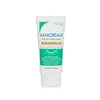What's inside
What's inside
 Key Ingredients
Key Ingredients

 Benefits
Benefits

 Concerns
Concerns

 Ingredients Side-by-side
Ingredients Side-by-side

Zinc Oxide
Cosmetic ColorantWater
Skin ConditioningC12-15 Alkyl Benzoate
AntimicrobialIsopentyldiol
HumectantSqualane
EmollientGlycerin
HumectantCoco-Caprylate/Caprate
EmollientBis-Octyldodecyl Dimer Dilinoleate/Propanediol Copolymer
EmollientGlyceryl Stearate
EmollientPEG-100 Stearate
Polyhydroxystearic Acid
EmulsifyingCetearyl Alcohol
EmollientSucrose Stearate
EmollientCeramide EOP
Skin ConditioningCeramide Ng
Skin ConditioningCeramide NP
Skin ConditioningCeramide As
Skin ConditioningCeramide AP
Skin ConditioningCarnosine
Skin ConditioningPhytosterols
Skin ConditioningHydrogenated Lecithin
EmulsifyingDimethicone
EmollientTriethoxycaprylylsilane
Polyacrylate Crosspolymer-11
Emulsion StabilisingCaprylyl Glycol
Emollient1,2-Hexanediol
Skin ConditioningZinc Oxide, Water, C12-15 Alkyl Benzoate, Isopentyldiol, Squalane, Glycerin, Coco-Caprylate/Caprate, Bis-Octyldodecyl Dimer Dilinoleate/Propanediol Copolymer, Glyceryl Stearate, PEG-100 Stearate, Polyhydroxystearic Acid, Cetearyl Alcohol, Sucrose Stearate, Ceramide EOP, Ceramide Ng, Ceramide NP, Ceramide As, Ceramide AP, Carnosine, Phytosterols, Hydrogenated Lecithin, Dimethicone, Triethoxycaprylylsilane, Polyacrylate Crosspolymer-11, Caprylyl Glycol, 1,2-Hexanediol
Titanium Dioxide
Cosmetic ColorantZinc Oxide
Cosmetic ColorantC12-15 Alkyl Benzoate
AntimicrobialCaprylic/Capric Triglyceride
MaskingBeeswax
Emulsion StabilisingCopernicia Cerifera Wax
Neopentyl Glycol Diethylhexanoate
EmollientTribehenin
EmollientEuphorbia Cerifera Wax
PPG-3 Benzyl Ether Myristate
EmollientHydrogenated Dimer Dilinoleyl/Dimethylcarbonate Copolymer
Emulsion StabilisingHelianthus Annuus Seed Wax
Skin ConditioningMyristyl Myristate
EmollientStearyl/Octyldodecyl Citrate Crosspolymer
HumectantSimmondsia Chinensis Seed Oil
EmollientPolyglyceryl-10 Pentaoleate
EmulsifyingJojoba Esters
EmollientSolanum Lycopersicum Seed Oil
EmollientHelianthus Annuus Seed Oil
EmollientVaccinium Macrocarpon Seed Oil
Skin ConditioningNigella Sativa Seed Oil
EmollientRubus Idaeus Seed Oil
EmollientPolyhydroxystearic Acid
EmulsifyingCaprylyl Glycol
EmollientEthylhexylglycerin
Skin ConditioningSilica
AbrasiveAlumina
AbrasiveTitanium Dioxide, Zinc Oxide, C12-15 Alkyl Benzoate, Caprylic/Capric Triglyceride, Beeswax, Copernicia Cerifera Wax, Neopentyl Glycol Diethylhexanoate, Tribehenin, Euphorbia Cerifera Wax, PPG-3 Benzyl Ether Myristate, Hydrogenated Dimer Dilinoleyl/Dimethylcarbonate Copolymer, Helianthus Annuus Seed Wax, Myristyl Myristate, Stearyl/Octyldodecyl Citrate Crosspolymer, Simmondsia Chinensis Seed Oil, Polyglyceryl-10 Pentaoleate, Jojoba Esters, Solanum Lycopersicum Seed Oil, Helianthus Annuus Seed Oil, Vaccinium Macrocarpon Seed Oil, Nigella Sativa Seed Oil, Rubus Idaeus Seed Oil, Polyhydroxystearic Acid, Caprylyl Glycol, Ethylhexylglycerin, Silica, Alumina
 Reviews
Reviews

Ingredients Explained
These ingredients are found in both products.
Ingredients higher up in an ingredient list are typically present in a larger amount.
C12-15 Alkyl Benzoate is made up of Benzoic Acid and long chain alcohols. It has a low molecular weight.
C12-15 Alkyl Benzoate is an emollient and texture enhancer. Due to its solubility, it is often used in sunscreens to help evenly distribute active ingredients.
As an emollient, C12-15 Alkyl Benzoate helps soften and hydrate your skin. Emollients create a film on your skin that traps moisture within.
This ingredient has been reported to cause eye irritation.
Learn more about C12-15 Alkyl BenzoateCaprylyl Glycol is a humectant and emollient, meaning it attracts and preserves moisture.
It is a common ingredient in many products, especially those designed to hydrate skin. The primary benefits are retaining moisture, skin softening, and promoting a healthy skin barrier.
Though Caprylyl Glycol is an alcohol derived from fatty acids, it is not the kind that can dry out skin.
This ingredient is also used as a preservative to extend the life of products. It has slight antimicrobial properties.
Learn more about Caprylyl GlycolPolyhydroxystearic Acid is a soft wax made from castor oil.
It is is a texture thickener, emulsifier, and film-former. Emulsifiers prevent ingredients from separating, such as oils and waters.
Polyhydroxystearic Acid may not be fungal acne safe.
Learn more about Polyhydroxystearic AcidZinc Oxide is a mineral broad-spectrum UV filter; it is the broadest UVA and UVB reflector approved by the FDA. It also has skin protectant and skin soothing properties.
Zinc oxide is one of the most effective broad-spectrum UV filters. It protects against UVB, UVAII, and UVAI. In comparison to its counterpart titanium dioxide, zinc oxide provides uniform and extended UVA protection.
Another great benefit? This ingredient is highly photostable so it won't degrade easily under sunlight.
A common myth is that mineral UV filters are widely believed to primarily reflect UV light.
However, modern research shows titanium dioxide absorbs UV radiation like chemical filters (~95% absorption & 5% reflection).
Zinc oxide has great skin soothing properties so you'll likely find this in sunscreens formulated for sensitive skin or babies/children. It is unlikely to cause "eye sting" like other sunscreen ingredients.
Regulatory agencies consider zinc oxide to be non-toxic and safe. It has also been shown to not penetrate the skin.
Unfortunately, this ingredient does leave a visible white cast. This is why mineral sunscreens are often less cosmetically elegant than chemical or hybrid ones.
In cosmetics, zinc oxide can be found in both non-nano and nano-sized forms. The nano version is used to reduce white cast and improve the texture of sunscreen formulas.
There are ongoing concerns surrounding nano-zinc oxide's impact on marine ecosystems and whether it can be absorbed into skin.
Regarding marine ecosystems and coral reefs, there is no conclusive evidence that any form of zinc oxide (or any other sunscreen ingredients) will cause harm. The science is still developing but many consumers are keeping a close eye on this issue.
Please note, many destinations have reef-safety sunscreen rules. For instance, the U.S. Virgin Islands advises all visitors to use non-nano mineral sunscreens.
There has also been some stir about whether micronized or nano zinc oxide has potential photoxicity and absorption through the skin/lungs.
An in-vitro (done in a test tube or petri dish) study demonstrated micronized zinc oxide to have potential phototoxicity. There's no need to fret; the EU Commission's Scientific Committee on Consumer Safety has stated, "The relevance of these findings needs to be clarified by appropriate investigations in vivo." Or in other words, further studies done on living organisms are needed to prove this.
Current research shows zinc oxide nanoparticles do not penetrate intact or sunburned skin. They either remain on the surface or in the outermost layer of dead skin (stratum corneum).
Zinc oxide is one of only two classified mineral UV filters with titanium dioxide being the other one.
Fun fact: Zinc has been used throughout history as an ingredient in paint and medicine. An Indian text from 500BC is believed to list zinc oxide as a salve for open wound. The Ancient Greek physician Dioscorides has also mentioned the use of zinc as an ointment in 1AD.
Learn more about Zinc Oxide